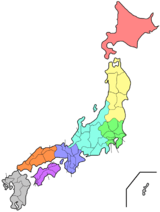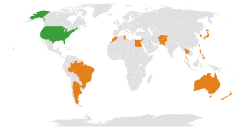Japan
Japan (Japanese: 日本, Nippon [ɲippoꜜɴ] (![]()
![]()
Japan
| |
|---|---|
.svg.png) Japanese territory in dark green; claimed but uncontrolled territory in light green | |
| Capital and largest city | Tokyo 35°41′N 139°46′E |
| National language | Japanese |
| Government | Unitary parliamentary constitutional monarchy |
• Emperor | Naruhito |
| Shinzō Abe | |
| Legislature | National Diet |
| House of Councillors | |
| House of Representatives | |
| Formation | |
| 539 AD (First verifiable date) | |
| November 29, 1890 | |
| May 3, 1947 | |
| Area | |
• Total | 377,975 km2 (145,937 sq mi)[2] (61st) |
| Population | |
• 2020 estimate | |
• 2015 census | 127,094,745[4] |
• Density | 334/km2 (865.1/sq mi) (24th) |
| GDP (PPP) | 2020 estimate |
• Total | |
• Per capita | |
| GDP (nominal) | 2020 estimate |
• Total | |
• Per capita | |
| Gini (2015) | 33.9[6] medium · 78th |
| HDI (2018) | very high · 19th |
| Currency | Japanese yen (¥) (JPY) |
| Time zone | UTC+09:00 (JST) |
| Driving side | left |
| Calling code | +81 |
| ISO 3166 code | JP |
| Internet TLD | .jp |
Japan is the 11th most populous country in the world, as well as one of the most densely populated and urbanized. About three-fourths of the country's terrain is mountainous, concentrating its population of 126.2 million on narrow coastal plains. Japan is administratively divided into 47 prefectures and traditionally divided into eight regions. The Greater Tokyo Area is the most populous metropolitan area in the world, with more than 37.4 million residents.
The islands of Japan were inhabited as early as the Upper Paleolithic period, though the first mentions of the archipelago appear in Chinese chronicles from the 1st century AD. Between the 4th and 9th centuries, the kingdoms of Japan became unified under an emperor and imperial court based in Heian-kyō. Starting in the 12th century, however, political power was held by a series of military dictators (shōgun), feudal lords (daimyō), and a class of warrior nobility (samurai). After a century-long period of civil war, the country was reunified in 1603 under the Tokugawa shogunate, which enacted a foreign policy of isolation. In 1854, a United States fleet forced Japan to open trade to the West, leading to the end of the shogunate and the restoration of imperial power in 1868. In the Meiji era, the Empire of Japan adopted a Western-style constitution and pursued industrialization and modernization. Japan invaded China in 1937; in 1941, it entered World War II as an Axis power. After suffering defeat in the Pacific War and two atomic bombings, Japan surrendered in 1945 and came under an Allied occupation, during which it adopted a post-war constitution. It has since maintained a unitary parliamentary constitutional monarchy with an elected legislature known as the National Diet.
Japan is a great power and a member of numerous international organizations, including the United Nations (since 1956), the OECD, and the G7. Although it has renounced its right to declare war, the country maintains a modern military ranked as the world's fourth most powerful. Following World War II, Japan experienced record economic growth, becoming the second-largest economy in the world by 1990. As of 2019, the country's economy is the third-largest by nominal GDP and fourth-largest by purchasing power parity. Japan is a global leader in the automotive and electronics industries and has made significant contributions to science and technology. Ranked "very high" on the Human Development Index, Japan has the world's second-highest life expectancy, though it is currently experiencing a decline in population. Culturally, Japan is renowned for its art, cuisine, music, and popular culture, including its prominent animation and video game industries.
Etymology
| Japan | |||||
|---|---|---|---|---|---|
| Japanese name | |||||
| Kanji | 日本国 | ||||
| Hiragana | にっぽんこく にほんこく | ||||
| Katakana | ニッポンコク ニホンコク | ||||
| |||||
The name for Japan in Japanese is written using the kanji 日本 and pronounced Nippon or Nihon.[8] Before it was adopted in the early 8th century, the country was known in China as Wa (倭) and in Japan by the endonym Yamato.[9] Nippon, the original Sino-Japanese reading of the characters, is favored today for official uses, including on banknotes and postage stamps.[8] Nihon is typically used in everyday speech and reflects shifts in Japanese phonology during the Edo period.[9] The characters 日本 mean "sun origin", in reference to Japan's relatively eastern location.[8] It is the source of the popular Western epithet "Land of the Rising Sun".[10]
The name Japan is based on the Chinese pronunciation and was introduced to European languages through early trade. In the 13th century, Marco Polo recorded the early Mandarin or Wu Chinese pronunciation of the characters 日本國 as Cipangu.[11] The old Malay name for Japan, Japang or Japun, was borrowed from a southern coastal Chinese dialect and encountered by Portuguese traders in Southeast Asia, who brought the word to Europe in the early 16th century.[12] The first version of the name in English appears in a book published in 1577, which spelled the name as Giapan in a translation of a 1565 Portuguese letter.[13][14]
History
Prehistoric to classical history

A Paleolithic culture from around 30,000 BC constitutes the first known habitation of the islands of Japan.[15] This was followed from around 14,500 BC (the start of the Jōmon period) by a Mesolithic to Neolithic semi-sedentary hunter-gatherer culture characterized by pit dwelling and rudimentary agriculture.[16] Decorated clay vessels from the period are among the oldest surviving examples of pottery.[17] From around 1000 BC, Yayoi people began to enter the archipelago from Kyushu, intermingling with the Jōmon;[18] the Yayoi period saw the introduction of practices including wet-rice farming,[19] a new style of pottery,[20] and metallurgy from China and Korea.[21]
Japan first appears in written history in the Chinese Book of Han, completed in 111 AD.[22] The Records of the Three Kingdoms records that the most powerful state on the archipelago in the 3rd century was Yamato; according to legend, the kingdom was founded in 660 BC by Emperor Jimmu. However, most scholars agree that Emperor Jimmu is a myth, and agree that the first verifiable Emperor was Emperor Kinmei (欽明天皇, Kinmei-tennō, 509–571).[23] Buddhism was introduced to Japan from Baekje (a Korean kingdom) in 552, but the subsequent development of Japanese Buddhism was primarily influenced by China.[24] Despite early resistance, Buddhism was promoted by the ruling class, including figures like Prince Shōtoku, and gained widespread acceptance beginning in the Asuka period (592–710).[25]
After defeat in the Battle of Baekgang by the Chinese Tang dynasty, the Japanese government devised and implemented the far-reaching Taika Reforms. It nationalized all land in Japan, to be distributed equally among cultivators, and ordered the compilation of a household registry as the basis for a new system of taxation.[26] The Jinshin War of 672, a bloody conflict between Prince Ōama and his nephew Prince Ōtomo, became a major catalyst for further administrative reforms.[27] These reforms culminated with the promulgation of the Taihō Code, which consolidated existing statutes and established the structure of the central and subordinate local governments.[26] These legal reforms created the ritsuryō state, a system of Chinese-style centralized government that remained in place for half a millennium.[27]
The Nara period (710–784) marked an emergence of a Japanese state centered on the Imperial Court in Heijō-kyō (modern Nara). The period is characterized by the appearance of a nascent literary culture with the completion of the Kojiki (712) and Nihon Shoki (720), as well as the development of Buddhist-inspired artwork and architecture.[28] A smallpox epidemic in 735–737 is believed to have killed as much as one-third of Japan's population.[29] In 784, Emperor Kanmu moved the capital from Nara to Nagaoka-kyō, then to Heian-kyō (modern Kyoto) in 794. This marked the beginning of the Heian period (794–1185), during which a distinctly indigenous Japanese culture emerged. Murasaki Shikibu's The Tale of Genji and the lyrics of Japan's national anthem "Kimigayo" were written during this time.[30]
Feudal era
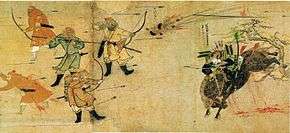
Japan's feudal era was characterized by the emergence and dominance of a ruling class of warriors, the samurai. In 1185, following the defeat of the Taira clan in the Genpei War, samurai Minamoto no Yoritomo was appointed shōgun and established a military government at Kamakura.[31] After Yoritomo's death, the Hōjō clan came to power as regents for the shōguns. The Zen school of Buddhism was introduced from China in the Kamakura period (1185–1333) and became popular among the samurai class.[32] The Kamakura shogunate repelled Mongol invasions in 1274 and 1281 but was eventually overthrown by Emperor Go-Daigo. Go-Daigo was defeated by Ashikaga Takauji in 1336, beginning the Muromachi period (1336–1573). However, the succeeding Ashikaga shogunate failed to control the feudal warlords (daimyōs) and a civil war began in 1467, opening the century-long Sengoku period ("Warring States").[33]
During the 16th century, Portuguese traders and Jesuit missionaries reached Japan for the first time, initiating direct commercial and cultural exchange between Japan and the West. Oda Nobunaga used European technology and firearms to conquer many other daimyōs; his consolidation of power began what was known as the Azuchi–Momoyama period (1573–1603). After Nobunaga was assassinated in 1582 by Akechi Mitsuhide, his successor Toyotomi Hideyoshi unified the nation in 1590 and launched two unsuccessful invasions of Korea in 1592 and 1597.
Tokugawa Ieyasu served as regent for Hideyoshi's son Toyotomi Hideyori and used his position to gain political and military support. When open war broke out, Ieyasu defeated rival clans in the Battle of Sekigahara in 1600. He was appointed shōgun by Emperor Go-Yōzei in 1603 and established the Tokugawa shogunate at Edo (modern Tokyo).[34] The shogunate enacted measures including buke shohatto, as a code of conduct to control the autonomous daimyōs,[35] and in 1639 the isolationist sakoku ("closed country") policy that spanned the two and a half centuries of tenuous political unity known as the Edo period (1603–1868).[36] Modern Japan's economic growth began in this period, resulting in roads and water transportation routes, as well as financial instruments such as futures contracts, banking and insurance of the Osaka rice brokers.[37] The study of Western sciences (rangaku) continued through contact with the Dutch enclave at Dejima in Nagasaki. The Edo period also gave rise to kokugaku ("national studies"), the study of Japan by the Japanese.[38]
Modern era

In 1854, Commodore Matthew Perry and the "Black Ships" of the United States Navy forced the opening of Japan to the outside world with the Convention of Kanagawa. Similar treaties with Western countries in the Bakumatsu period brought economic and political crises. The resignation of the shōgun led to the Boshin War and the establishment of a centralized state nominally unified under the emperor (the Meiji Restoration).[39] Adopting Western political, judicial, and military institutions, the Cabinet organized the Privy Council, introduced the Meiji Constitution, and assembled the Imperial Diet. During the Meiji era (1868–1912), the Empire of Japan emerged as the most developed nation in Asia and as an industrialized world power that pursued military conflict to expand its sphere of influence.[40][41][42] After victories in the First Sino-Japanese War (1894–1895) and the Russo-Japanese War (1904–1905), Japan gained control of Taiwan, Korea and the southern half of Sakhalin.[43] The Japanese population doubled from 35 million in 1873 to 70 million by 1935.[44]
The early 20th century saw a period of Taishō democracy (1912–1926) overshadowed by increasing expansionism and militarization. World War I allowed Japan, which joined the side of the victorious Allies, to capture German possessions in the Pacific and in China. The 1920s saw a political shift towards statism, the passing of laws against political dissent, and a series of attempted coups. This process accelerated during the 1930s, spawning a number of Radical Nationalist groups that shared a hostility to liberal democracy and a dedication to expansion in Asia. In 1931, Japan invaded and occupied Manchuria; following international condemnation of the occupation, it resigned from the League of Nations two years later. In 1936, Japan signed the Anti-Comintern Pact with Nazi Germany; the 1940 Tripartite Pact made it one of the Axis Powers.
The Empire of Japan invaded other parts of China in 1937, precipitating the Second Sino-Japanese War (1937–1945). In 1940, the Empire invaded French Indochina, after which the United States placed an oil embargo on Japan.[45] On December 7–8, 1941, Japanese forces carried out surprise attacks on Pearl Harbor, as well as on British forces in Malaya, Singapore, and Hong Kong, and declared war on the United States and the British Empire, beginning World War II in the Pacific. After Allied victories during the next four years, which culminated in the Soviet invasion of Manchuria and the atomic bombings of Hiroshima and Nagasaki in 1945, Japan agreed to an unconditional surrender.[46] The war cost Japan its colonies, China and the war's other combatants tens of millions of lives, and left much of Japan's industry and infrastructure destroyed. The Allies (led by the United States) repatriated millions of ethnic Japanese from colonies and military camps throughout Asia, largely eliminating the Japanese empire and its influence over its conquered territories.[47] The Allies also convened the International Military Tribunal for the Far East to prosecute Japanese leaders for war crimes.
In 1947, Japan adopted a new constitution emphasizing liberal democratic practices. The Allied occupation ended with the Treaty of San Francisco in 1952,[48] and Japan was granted membership in the United Nations in 1956. A period of record growth propelled Japan to become the second-largest economy in the world; this ended in the mid-1990s after the popping of an asset price bubble, beginning the "Lost Decade". In the 21st century, positive growth has signaled a gradual economic recovery.[49] On March 11, 2011, Japan suffered one of the largest earthquakes in its recorded history, triggering the Fukushima Daiichi nuclear disaster.[50] On May 1, 2019, after the historic abdication of Emperor Akihito, his son Naruhito became the new emperor, beginning the Reiwa era.[51]
Geography
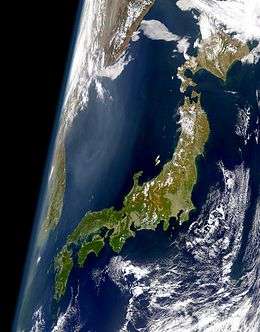
Japan comprises 6,852 islands extending along the Pacific coast of Asia. It stretches over 3,000 km (1,900 mi) northeast–southwest from the Sea of Okhotsk to the East China and Philippine Seas.[52] The county's five main islands, from north to south, are Hokkaido, Honshu, Shikoku, Kyushu and Okinawa.[53] The Ryukyu Islands, which include Okinawa, are a chain to the south of Kyushu. The Nanpō Islands are south and east of the main islands of Japan. Together they are often known as the Japanese archipelago.[54] As of 2019, Japan's territory is 377,975.24 km2 (145,937.06 sq mi).[2] Japan has the sixth longest coastline in the world (29,751 km (18,486 mi)). Because of its many far-flung outlying islands, Japan has the eighth largest Exclusive Economic Zone in the world covering 4,470,000 km2 (1,730,000 sq mi).[55]
About 73 percent of Japan is forested, mountainous and unsuitable for agricultural, industrial or residential use.[56][57] As a result, the habitable zones, mainly in coastal areas, have extremely high population densities: Japan is one of the most densely populated countries.[58] Approximately 0.5% of Japan's total area is reclaimed land (umetatechi). Late 20th and early 21st century projects include artificial islands such as Chubu Centrair International Airport in Ise Bay, Kansai International Airport in the middle of Osaka Bay, Yokohama Hakkeijima Sea Paradise and Wakayama Marina City.[59]

Japan is substantially prone to earthquakes, tsunami and volcanoes because of its location along the Pacific Ring of Fire.[60] It has the 15th highest natural disaster risk as measured in the 2013 World Risk Index.[61] Japan has 108 active volcanoes, which are primarily the result of large oceanic movements occurring from the mid-Silurian to the Pleistocene as a result of the subduction of the Philippine Sea Plate beneath the continental Amurian Plate and Okinawa Plate to the south, and subduction of the Pacific Plate under the Okhotsk Plate to the north. Japan was originally attached to the Eurasian continent; the subducting plates opened the Sea of Japan around 15 million years ago.[62] During the twentieth century several new volcanoes emerged, including Shōwa-shinzan on Hokkaido and Myōjin-shō off the Bayonnaise Rocks. Destructive earthquakes, often resulting in tsunami, occur several times each century.[63] The 1923 Tokyo earthquake killed over 140,000 people.[64] More recent major quakes are the 1995 Great Hanshin earthquake and the 2011 Tōhoku earthquake, which triggered a large tsunami.[50]
Climate

The climate of Japan is predominantly temperate but varies greatly from north to south. Japan's geographical features divide it into six principal climatic zones: Hokkaido, Sea of Japan, Central Highland, Seto Inland Sea, Pacific Ocean, and Ryukyu Islands. The northernmost zone, Hokkaido, has a humid continental climate with long, cold winters and very warm to cool summers. Precipitation is not heavy, but the islands usually develop deep snowbanks in the winter.[65] In the Sea of Japan zone on Honshu's west coast, northwest winter winds bring heavy snowfall. In the summer, the region is cooler than the Pacific area, though it sometimes experiences extremely hot temperatures because of the foehn. The Central Highland has a typical inland humid continental climate, with large temperature differences between summer and winter, as well as large diurnal variation; precipitation is light, though winters are usually snowy. The mountains of the Chūgoku and Shikoku regions shelter the Seto Inland Sea from seasonal winds, bringing mild weather year-round.[65] The Pacific coast features a humid subtropical climate that experiences milder winters with occasional snowfall and hot, humid summers because of the southeast seasonal wind. The Ryukyu and Nanpō Islands have a subtropical climate, with warm winters and hot summers. Precipitation is very heavy, especially during the rainy season.[65]
The average winter temperature in Japan is 5.1 °C (41.2 °F) and the average summer temperature is 25.2 °C (77.4 °F).[66] The highest temperature ever measured in Japan, 41.1 °C (106.0 °F), was recorded on July 23, 2018.[67] The main rainy season begins in early May in Okinawa, and the rain front gradually moves north until reaching Hokkaido in late July. In late summer and early autumn, typhoons often bring heavy rain.[66]
Biodiversity
Japan has nine forest ecoregions which reflect the climate and geography of the islands. They range from subtropical moist broadleaf forests in the Ryūkyū and Bonin Islands, to temperate broadleaf and mixed forests in the mild climate regions of the main islands, to temperate coniferous forests in the cold, winter portions of the northern islands.[68] Japan has over 90,000 species of wildlife, including the brown bear, the Japanese macaque, the Japanese raccoon dog, the large Japanese field mouse, and the Japanese giant salamander.[69] A large network of national parks has been established to protect important areas of flora and fauna as well as 37 Ramsar wetland sites.[70][71] Four sites have been inscribed on the UNESCO World Heritage List for their outstanding natural value.[72]
Environment
In the period of rapid economic growth after World War II, environmental policies were downplayed by the government and industrial corporations; as a result, environmental pollution was widespread in the 1950s and 1960s. Responding to rising concern, the government introduced several environmental protection laws in 1970.[73] The oil crisis in 1973 also encouraged the efficient use of energy because of Japan's lack of natural resources.[74]
As of 2015, more than 40 coal-fired power plants are planned or under construction in Japan, following the switching-off of Japan's nuclear fleet following the 2011 Fukushima nuclear disaster. Prior to this incident, Japan's emissions had been on the decline, largely because their nuclear power plants created no emissions. Japan ranks 20th in the 2018 Environmental Performance Index, which measures a nation's commitment to environmental sustainability.[75] As the host and signatory of the 1997 Kyoto Protocol, Japan is under treaty obligation to reduce its carbon dioxide emissions and to take other steps to curb climate change.[76] Current environmental issues include urban air pollution (NOx, suspended particulate matter, and toxics), waste management, water eutrophication, nature conservation, climate change, chemical management and international co-operation for conservation.[77]
Politics
Japan is a unitary state and constitutional monarchy in which the power of the Emperor is limited to a ceremonial role. He is defined in the Constitution as "the symbol of the state and of the unity of the people". Executive power is instead wielded by the Prime Minister of Japan and his Cabinet, whose sovereignty is vested in the Japanese people.[78] Naruhito is the current Emperor of Japan, having succeeded his father Akihito upon his accession to the Chrysanthemum Throne on May 1, 2019.
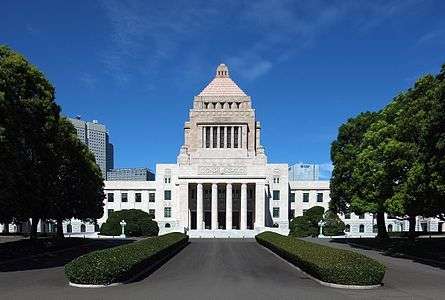
Japan's legislative organ is the National Diet, a bicameral parliament. It consists of a lower House of Representatives with 465 seats, elected by popular vote every four years or when dissolved, and an upper House of Councillors with 245 seats, whose popularly-elected members serve six-year terms. There is universal suffrage for adults over 18 years of age,[79] with a secret ballot for all elected offices.[78] The Diet is currently dominated by the conservative Liberal Democratic Party (LDP), which has enjoyed near-continuous electoral success since 1955. The prime minister is the head of government and is appointed by the emperor after being designated from among the members of the Diet. As the head of the Cabinet, the prime minister has the power to appoint and dismiss Ministers of State. Following the LDP victory in the 2012 general election, Shinzō Abe replaced Yoshihiko Noda as the prime minister.[80]
Historically influenced by Chinese law, the Japanese legal system developed independently during the Edo period through texts such as Kujikata Osadamegaki.[81] However, since the late 19th century, the judicial system has been largely based on the civil law of Europe, notably Germany. In 1896, Japan established a civil code based on the German Bürgerliches Gesetzbuch, which remains in effect with post–World War II modifications.[82] The Constitution of Japan, adopted in 1947, is the oldest unamended constitution in the world.[83] Statutory law originates in the legislature, and the constitution requires that the emperor promulgate legislation passed by the Diet without giving him the power to oppose legislation. The main body of Japanese statutory law is called the Six Codes.[84] Japan's court system is divided into four basic tiers: the Supreme Court and three levels of lower courts.[85]
Administrative divisions
Japan is divided into 47 prefectures, each overseen by an elected governor, legislature, and administrative bureaucracy.[86] Each prefecture is further divided into cities, towns and villages.[87] In the following table, the prefectures are grouped by region:
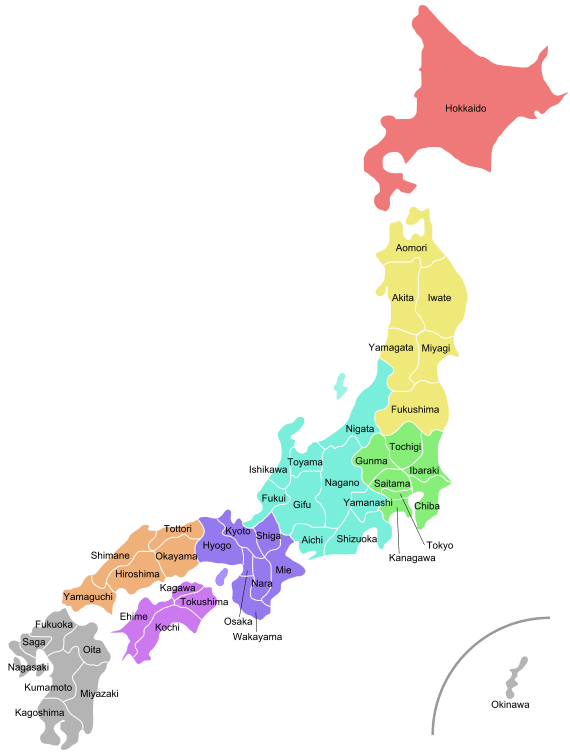
|
1. Hokkaido |
2. Aomori |
8. Ibaraki |
15. Niigata |
|
24. Mie |
31. Tottori |
|
40. Fukuoka |
Foreign relations
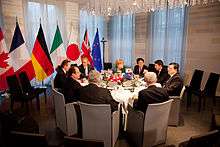
A member state of the United Nations since 1956, Japan has served as a non-permanent Security Council member for a total of 22 years. It is one of the G4 nations seeking permanent membership in the Security Council.[88] Japan is a member of the G7, APEC, and "ASEAN Plus Three", and is a participant in the East Asia Summit. Japan signed a security pact with Australia in March 2007[89] and with India in October 2008.[90] It is the world's fifth largest donor of official development assistance, donating US$9.2 billion in 2014.[91] In 2017, Japan had the fifth largest diplomatic network in the world.[92]
Japan has close economic and military relations with the United States; the US-Japan security alliance acts as the cornerstone of the nation's foreign policy.[93] The United States is a major market for Japanese exports and the primary source of Japanese imports and is committed to defending the country, having military bases in Japan for partially that purpose.[94]
Japan's relationship with South Korea has been strained because of Japan's treatment of Koreans during Japanese colonial rule, particularly over the issue of comfort women.[95] In December 2015, Japan agreed to settle the comfort women dispute with South Korea by issuing a formal apology and paying money to the surviving comfort women. Today, South Korea and Japan have a stronger and more economically-driven relationship. Since the 1990s, the Korean Wave has created a large fanbase in East Asia: Japan is the number one importer of Korean music (K-pop), television (K-dramas), and films.[96] Most recently, South Korean President Moon Jae-in met with Japanese Prime Minister Shinzo Abe at the 2017 G20 Summit to discuss the future of their relationship and specifically how to cooperate on finding solutions for North Korean aggression in the region.[97]
Japan is engaged in several territorial disputes with its neighbors. Japan contests Russia's control of the Southern Kuril Islands, which were occupied by the Soviet Union in 1945.[98] South Korea's control of the Liancourt Rocks is acknowledged but not accepted as they are claimed by Japan.[99] Japan has strained relations with China and Taiwan over the Senkaku Islands[100] and the status of Okinotorishima.
Military
_destroyer_JDS_Kongou_(DDG_173)_sails_in_formation_with_other_JMSDF_ships_and_ships_assigned_to_the_USS_Kitty_Hawk_Carrier_Strike_Group.jpg)
Japan maintains one of the largest military budgets of any country in the world.[101] The country's military (the Japan Self-Defense Forces) is restricted by Article 9 of the Japanese Constitution, which renounces Japan's right to declare war or use military force in international disputes. Japan is the highest-ranked Asian country in the Global Peace Index.
The military is governed by the Ministry of Defense, and primarily consists of the Japan Ground Self-Defense Force, the Japan Maritime Self-Defense Force, and the Japan Air Self-Defense Force. The Maritime Self-Defense Force is a regular participant in RIMPAC maritime exercises.[102] The forces have been recently used in peacekeeping operations; the deployment of troops to Iraq marked the first overseas use of Japan's military since World War II.[103] The Japan Business Federation has called on the government to lift the ban on arms exports so that Japan can join multinational projects such as the Joint Strike Fighter.[104]
The Government of Japan has been making changes to its security policy which include the establishment of the National Security Council, the adoption of the National Security Strategy, and the development of the National Defense Program Guidelines.[105] In May 2014, Prime Minister Shinzō Abe said Japan wanted to shed the passiveness it has maintained since the end of World War II and take more responsibility for regional security.[106] Recent tensions, particularly with North Korea,[107] have reignited the debate over the status of the JSDF and its relation to Japanese society.[108]
Domestic law enforcement
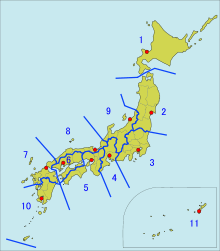
Domestic security in Japan is provided mainly by the prefectural police departments, under the oversight of the National Police Agency[109] and supervised by the Criminal Affairs Bureau of the National Police Agency.[110] As the central coordinating body for the Prefectural Police Departments, the National Police Agency is administered by the National Public Safety Commission.[111] The Special Assault Team comprises national-level counter-terrorism tactical units that cooperate with territorial-level Anti-Firearms Squads and Counter-NBC Terrorism Squads.[112]
Additionally, there is the Japan Coast Guard which guards territorial waters. The coast guard patrols the sea surrounding Japan and uses surveillance and control countermeasures against smuggling, marine environmental crime, poaching, piracy, spy ships, unauthorized foreign fishing vessels, and illegal immigration.[113]
The Firearm and Sword Possession Control Law strictly regulates the civilian ownership of guns, swords and other weaponry.[114][115] According to the United Nations Office on Drugs and Crime, among the member states of the UN that report statistics, the incidence rate of violent crimes such as murder, abduction, forced sexual intercourse and robbery is very low in Japan.[116][117][118][119][120]
Economy
Japan is the third largest national economy in the world, after the United States and China, in terms of nominal GDP,[121] and the fourth largest national economy in the world, after the United States, China and India, in terms of purchasing power parity. As of 2017, Japan's public debt was estimated at more than 230 percent of its annual gross domestic product, the largest of any nation in the world.[122] The service sector accounts for three quarters of the gross domestic product.[123]
As of 2017, Japan's labor force consisted of some 65 million workers.[56] Japan has a low unemployment rate of around three percent. Around 16 percent of the population were below the poverty line in 2013.[124] Housing in Japan is characterized by limited land supply in urban areas.[125]
Japan's exports amounted to US$5,430 per capita in 2017. As of 2017, Japan's main export markets were the United States (19.4 percent), China (19 percent), South Korea (7.6 percent), Hong Kong (5.1 percent) and Thailand (4.2 percent). Its main exports are transportation equipment, motor vehicles, iron and steel products, semiconductors and auto parts.[56] Japan's main import markets as of 2017 were China (24.5 percent), the United States (11 percent), Australia (5.8 percent), South Korea (4.2 percent), and Saudi Arabia (4.1 percent).[56] Japan's main imports are machinery and equipment, fossil fuels, foodstuffs (in particular beef), chemicals, textiles and raw materials for its industries. By market share measures, domestic markets are the least open of any OECD country.[126]
Japan ranks 34th of 190 countries in the 2018 ease of doing business index and has one of the smallest tax revenues of the developed world. The Japanese variant of capitalism has many distinct features: keiretsu enterprises are influential, and lifetime employment and seniority-based career advancement are relatively common in the Japanese work environment.[126][127] Japanese companies are known for management methods like "The Toyota Way", and shareholder activism is rare.[128] Japan also has a large cooperative sector, with three of the ten largest cooperatives in the world, including the largest consumer cooperative and the largest agricultural cooperative in the world.[129]
Japan ranks highly for competitiveness and economic freedom. It is ranked sixth in the Global Competitiveness Report for 2015–2016.[130][131]
Agriculture and fishery
The Japanese agricultural sector accounts for about 1.4% of the total country's GDP.[132] Only 12% of Japan's land is suitable for cultivation.[133][134] Because of this lack of arable land, a system of terraces is used to farm in small areas.[135] This results in one of the world's highest levels of crop yields per unit area, with an overall agricultural self-sufficiency rate of about 50% on fewer than 56,000 square kilometers (14,000,000 acres) cultivated. Japan's small agricultural sector, however, is also highly subsidized and protected, with government regulations that favor small-scale cultivation instead of large-scale agriculture.[133] Rice, the most protected crop, is subject to tariffs of 777.7%.[134][136] There has been a growing concern about farming as the current farmers are aging with a difficult time finding successors.[137]
In 1996, Japan ranked fourth in the world in tonnage of fish caught.[138] Japan ranked seventh and captured 3,167,610 metric tons of fish in 2016, down from an annual average of 4,000,000 tons over the previous decade.[139] In 2010, Japan's total fisheries production was 4,762,469 fish.[140] Japan maintains one of the world's largest fishing fleets and accounts for nearly 15% of the global catch,[141] prompting some claims that Japan's fishing is leading to depletion in fish stocks such as tuna.[142] Japan has also sparked controversy by supporting quasi-commercial whaling.[143]
Industry

Japan has a large industrial capacity and is home to some of the largest and most technologically advanced producers of motor vehicles, machine tools, steel and nonferrous metals, ships, chemical substances, textiles, and processed foods. Japan's industrial sector makes up approximately 27.5% of its GDP.[141] Some major Japanese industrial companies include Canon Inc., Toshiba and Nippon Steel.[141][145] The country's manufacturing output is the third highest in the world.[146]
Japan is the third largest automobile producer in the world and is home to Toyota, the world's largest automobile company.[144][147] Despite facing competition from South Korea and China, the Japanese shipbuilding industry is expected to remain strong through an increased focus on specialized, high-tech designs.[148]
Services and tourism
Japan's service sector accounts for about three-quarters of its total economic output.[132] Banking, insurance, real estate, retailing, transportation, and telecommunications are all major industries, with companies such as Mitsubishi UFJ, Mizuho, NTT, TEPCO, Nomura, Mitsubishi Estate, ÆON, Mitsui Sumitomo, Softbank, JR East, Seven & I, KDDI and Japan Airlines listed as some of the largest in the world.[149][150] Four of the five most circulated newspapers in the world are Japanese newspapers.[151] The six major keiretsus are the Mitsubishi, Sumitomo, Fuyo, Mitsui, Dai-Ichi Kangyo and Sanwa Groups.[152]
Japan attracted 19.73 million international tourists in 2015[153] and increased by 21.8% to attract 24.03 million international tourists in 2016.[154][155][156] In 2008, the Japanese government set up Japan Tourism Agency and set the initial goal to increase foreign visitors to 20 million in 2020. In 2016, having met the 20 million target, the government revised up its target to 40 million by 2020 and to 60 million by 2030.[157][158] For inbound tourism, Japan was ranked 16th in the world in 2015.[159] Japan is one of the least visited countries in the OECD on a per capita basis,[160] and it was by far the least visited country in the G7 until 2014.[161]
Science and technology

Japan is a leading nation in scientific research, particularly in the natural sciences and engineering. The country ranks second among the most innovative countries in the Bloomberg Innovation Index.[162][163] Nearly 700,000 researchers share a US$130 billion research and development budget,[164] which relative to gross domestic product is the third highest budget in the world.[165] The country is a world leader in fundamental scientific research, having produced twenty-two Nobel laureates in either physics, chemistry or medicine[166] and three Fields medalists.[167]
Japanese scientists and engineers have contributed to the advancement of agricultural sciences, electronics, industrial robotics, optics, chemicals, semiconductors, life sciences and various fields of engineering. Japan leads the world in robotics production and use, possessing more than 20% of the world's industrial robots as of 2013.[168] Japan boasts the third highest number of scientists, technicians, and engineers per capita in the world with 83 per 10,000 employees.[169][170][171]
The Japanese consumer electronics industry, once considered the strongest in the world, is currently in a state of decline as competition arises in countries like South Korea, the United States and China.[172][173] However, video gaming in Japan remains a major industry. Japan became a major exporter of video games during the golden age of arcade video games, an era that began with the release of Taito's Space Invaders in 1978 and ended around the mid-1980s.[174][175][176] Japanese-made video game consoles have been popular since the 1980s,[177] and Japan dominated the industry until Microsoft's Xbox consoles began challenging Sony and Nintendo in the 2000s.[178][179][180] As of 2009, $6 billion of Japan's $20 billion gaming market is generated from arcades, which represent the largest sector of the Japanese video game market, followed by home console games and mobile games at $3.5 billion and $2 billion, respectively.[181] Japan is now the world's largest market for mobile games;[182] in 2014, Japan's consumer video game market grossed $9.6 billion, with $5.8 billion coming from mobile gaming.[183]
The Japan Aerospace Exploration Agency is Japan's national space agency; it conducts space, planetary, and aviation research, and leads development of rockets and satellites. It is a participant in the International Space Station: the Japanese Experiment Module (Kibō) was added to the station during Space Shuttle assembly flights in 2008.[184] The space probe Akatsuki was launched in 2010 and achieved orbit around Venus in 2015. Japan's plans in space exploration include building a moon base by 2030.[185] In 2007, it launched lunar explorer SELENE (Selenological and Engineering Explorer) from Tanegashima Space Center. The largest lunar mission since the Apollo program, its purpose was to gather data on the moon's origin and evolution. It entered a lunar orbit on October 4, 2007,[186][187] and was deliberately crashed into the Moon on June 11, 2009.[188]
Infrastructure
Transportation
.jpg)
Japan's road spending has been extensive.[189] Its 1.2 million kilometers (0.75 million miles) of paved road are the main means of transportation.[190] As of 2012, Japan has approximately 1,215,000 kilometers (755,000 miles) of roads made up of 1,022,000 kilometers (635,000 miles) of city, town and village roads, 129,000 kilometers (80,000 miles) of prefectural roads, 55,000 kilometers (34,000 miles) of general national highways and 8,050 kilometers (5,000 miles) of national expressways.[191][192] A single network of high-speed, divided, limited-access toll roads connects major cities on Honshu, Shikoku and Kyushu (Hokkaido has a separate network). Cars are inexpensive; car ownership fees and fuel levies are used to promote energy efficiency. However, at just 50 percent of all distance traveled, car usage is the lowest of all G8 countries.[193]
Since privatization in 1987, dozens of Japanese railway companies compete in regional and local passenger transportation markets; major companies include seven JR enterprises, Kintetsu, Seibu Railway and Keio Corporation. Some 250 high-speed Shinkansen trains connect major cities and Japanese trains are known for their safety and punctuality.[194][195] A new Maglev line called the Chūō Shinkansen is being constructed between Tokyo and Nagoya. It is due to be completed in 2027.[196]
There are 175 airports in Japan;[56] the largest domestic airport, Haneda Airport in Tokyo, is Asia's second-busiest airport.[197] The largest international gateways are Narita International Airport, Kansai International Airport and Chūbu Centrair International Airport.[198] Nagoya Port is the country's largest and busiest port, accounting for 10 percent of Japan's trade value.[199]
Energy
.jpg)
As of 2017, 39% of energy in Japan was produced from petroleum, 25% from coal, 23% from natural gas, 3.5% from hydropower and 1.5% from nuclear power. Nuclear power was down from 11.2 percent in 2010.[200] By May 2012 all of the country's nuclear power plants had been taken offline because of ongoing public opposition following the Fukushima Daiichi nuclear disaster in March 2011, though government officials continued to try to sway public opinion in favor of returning at least some to service.[201] The Sendai Nuclear Power Plant restarted in 2015,[202] and since then several other nuclear power plants have been restarted. Japan lacks significant domestic reserves and so has a heavy dependence on imported energy.[203] Japan has therefore aimed to diversify its sources and maintain high levels of energy efficiency.[204]
Water supply and sanitation
The government took responsibility for regulating the water and sanitation sector is shared between the Ministry of Health, Labor and Welfare in charge of water supply for domestic use; the Ministry of Land, Infrastructure, Transport and Tourism in charge of water resources development as well as sanitation; the Ministry of the Environment in charge of ambient water quality and environmental preservation; and the Ministry of Internal Affairs and Communications in charge of performance benchmarking of utilities.[205] Access to an improved water source is universal in Japan. 97% of the population receives piped water supply from public utilities and 3% receive water from their own wells or unregulated small systems, mainly in rural areas.[206]
Demographics
Japan has a population of 126.3 million,[207] of which 124.8 million are Japanese nationals (2019).[208] Honshū is the world's second most populous island and has 80% of Japan's population. In 2010, 90.7% of the total Japanese population lived in cities.[209] The capital city Tokyo has a population of 13.8 million (2018).[210] It is part of the Greater Tokyo Area, the biggest metropolitan area in the world with 38,140,000 people (2016).[211][212]
Japanese society is linguistically, ethnically and culturally homogeneous,[213][214] composed of 98.1% ethnic Japanese,[56] with small populations of foreign workers.[213] The most dominant native ethnic group is the Yamato people; primary minority groups include the indigenous Ainu[215] and Ryukyuan people, as well as social minority groups like the burakumin.[216] Zainichi Koreans,[217] Chinese, Filipinos, Brazilians mostly of Japanese descent,[218] Peruvians mostly of Japanese descent, and Americans are among the small minority groups in Japan.[219] In 2003, there were about 134,700 non-Latin American Western (not including more than 33,000 American military personnel and their dependents) and 345,500 Latin American expatriates, 274,700 of whom were Brazilians,[218] the largest community of Westerners.[220]
Japan has the second longest overall life expectancy at birth of any country in the world: 83.5 years for persons born in the period 2010–2015.[221][222] The Japanese population is rapidly aging as a result of a post–World War II baby boom followed by a decrease in birth rates. In 2012, about 24.1 percent of the population was over 65, and the proportion is projected to rise to almost 40 percent by 2050.[223] On September 15, 2018, for the first time, one in five Japanese residents was aged 70 or older. 26.18 million people are 70 or older and accounted for 20.7 percent of the population. Elderly women crossed the 20 million line at 20.12 million, substantially outnumbering the nation's 15.45 million elderly men.[224] The changes in demographic structure have created a number of social issues, particularly a potential decline in workforce population and increase in the cost of social security benefits.[225] A growing number of younger Japanese are not marrying or remain childless.[226] Japan's population is expected to drop to 95 million by 2050.[223][227]
Immigration and birth incentives are sometimes suggested as a solution to provide younger workers to support the nation's aging population.[228][229] Japan accepts an average flow of 9,500 new naturalized citizens per year.[230] On April 1, 2019, Japan's revised immigration law was enacted, protecting the rights of foreign workers to help reduce labor shortages in certain sectors.[231]
Religion
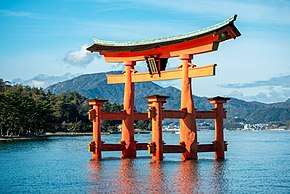
Japan has full religious freedom based on its constitution. Upper estimates suggest that 84–96 percent of the Japanese population subscribe to Shinto as its indigenous religion (50% to 80% of which considering degrees of syncretism with Buddhism, shinbutsu-shūgō).[232][233] However, these estimates are based on people affiliated with a temple, rather than the number of true believers. Many Japanese people practice both Shinto and Buddhism;[234] they can either identify with both religions or describe themselves as non-religious or spiritual,[235] despite participating in religious ceremonies as a cultural tradition. As a result, religious statistics are often under-reported in Japan. Other studies have suggested that only 30 percent of the population identify themselves as belonging to a religion.[236] Nevertheless, the level of participation remains high, especially during festivals and occasions such as the first shrine visit of the New Year. Taoism and Confucianism from China have also influenced Japanese beliefs and customs.[237]
Christianity was first introduced into Japan by Jesuit missions starting in 1549.[238] Today, fewer than 1%[239][240][241] to 2.3% are Christians,[lower-alpha 2] most of them living in the western part of the country. As of 2007, there were 32,036 Christian priests and pastors in Japan.[243] Throughout the latest century, some Western customs originally related to Christianity (including Western style weddings, Valentine's Day and Christmas) have become popular as secular customs among many Japanese.[244]
Islam in Japan is estimated to constitute about 80–90% of foreign-born migrants and their children, primarily from Indonesia, Pakistan, Bangladesh, and Iran.[245] Many of the ethnic Japanese Muslims are those who convert upon marrying immigrant Muslims.[246] The Pew Research Center estimated that there were 185,000 Muslims in Japan in 2010.[247]
Other minority religions include Hinduism, Sikhism, Judaism, and Bahá'í Faith;[248] since the mid-19th century numerous new religious movements have emerged in Japan.[249]
Languages
More than 99 percent of the population speaks Japanese as their first language.[56] Japanese writing uses kanji (Chinese characters) and two sets of kana (syllabaries based on cursive script and radical of kanji), as well as the Latin alphabet and Arabic numerals.[250] Public and private schools generally require students to take Japanese language classes as well as English language courses.[251]
Besides Japanese, the Ryukyuan languages (Amami, Kunigami, Okinawan, Miyako, Yaeyama, Yonaguni), also part of the Japonic language family, are spoken in the Ryukyu Islands chain. Few children learn these languages,[252] but in recent years local governments have sought to increase awareness of the traditional languages. The Okinawan Japanese dialect is also spoken in the region. The Ainu language, which is a language isolate, is moribund, with only a few elderly native speakers remaining in Hokkaido.[253]
Education
Primary schools, secondary schools and universities were introduced in 1872 as a result of the Meiji Restoration.[254] Since 1947, compulsory education in Japan comprises elementary and junior high school, which together last for nine years (from age 6 to age 15). Almost all children continue their education at a three-year senior high school. The two top-ranking universities in Japan are the University of Tokyo and Kyoto University.[255] Japan's education system played a central part in the country's recovery after World War II when the Fundamental Law of Education and the School Education Law were enacted. The latter law defined the standard school system. Starting in April 2016, various schools began the academic year with elementary school and junior high school integrated into one nine-year compulsory schooling program; MEXT plans for this approach to be adopted nationwide.[256]
The Programme for International Student Assessment coordinated by the OECD currently ranks the overall knowledge and skills of Japanese 15-year-olds as the third best in the world.[257] Japan is one of the top-performing OECD countries in reading literacy, math and sciences with the average student scoring 529 and has one of the world's highest-educated labor forces among OECD countries.[258][257][259] In 2015, Japan's public spending on education amounted to just 4.1 percent of its GDP, below the OECD average of 5.0 percent.[260] The country's large pool of highly educated and skilled individuals is largely responsible for ushering Japan's post-war economic growth.[261] In 2017, the country ranked third for the percentage of 25 to 64 year-olds that have attained tertiary education with 51 percent.[261] In addition, 60.4 percent Japanese aged 25 to 34 have some form of tertiary education qualification and bachelor's degrees are held by 30.4 percent of Japanese aged 25 to 64, the second most in the OECD after South Korea.[261]
Health
Health care is provided by national and local governments. Payment for personal medical services is offered through a universal health insurance system that provides relative equality of access, with fees set by a government committee. People without insurance through employers can participate in a national health insurance program administered by local governments. Since 1973, all elderly persons have been covered by government-sponsored insurance.[262] Japan has a high suicide rate;[263][264] suicide is the leading cause of death for people under 30.[265] Another significant public health issue is smoking. Japan has the lowest rate of heart disease in the OECD, and the lowest level of dementia in the developed world.[266]
Culture
Contemporary Japanese culture combines influences from Asia, Europe and North America.[267] Traditional Japanese arts include crafts such as ceramics, textiles, lacquerware, swords and dolls; performances of bunraku, kabuki, noh, dance, and rakugo; and other practices, the tea ceremony, ikebana, martial arts, calligraphy, origami, onsen, Geisha and games. Japan has a developed system for the protection and promotion of both tangible and intangible Cultural Properties and National Treasures.[268] Twenty-two sites have been inscribed on the UNESCO World Heritage List, eighteen of which are of cultural significance.[72]
Art and architecture
Japanese sculpture, largely of wood, and Japanese painting are among the oldest of the Japanese arts, with early figurative paintings dating to at least 300 BC. The history of Japanese painting exhibits synthesis and competition between native Japanese esthetics and imported ideas.[269] The interaction between Japanese and European art has been significant: for example ukiyo-e prints, which began to be exported in the 19th century in the movement known as Japonism, had a significant influence on the development of modern art in the West, most notably on post-Impressionism.[269] Japanese manga developed in the 20th century and have become popular worldwide.[270]
Japanese architecture is a combination between local and other influences. It has traditionally been typified by wooden structures, elevated slightly off the ground, with tiled or thatched roofs. The Shrines of Ise have been celebrated as the prototype of Japanese architecture.[271] Largely of wood, traditional housing and many temple buildings see the use of tatami mats and sliding doors that break down the distinction between rooms and indoor and outdoor space.[272] Since the 19th century, however, Japan has incorporated much of Western, modern, and post-modern architecture into construction and design. Architects returning from study with western architects introduced the International Style of modernism into Japan. However, it was not until after World War II that Japanese architects made an impression on the international scene, firstly with the work of architects like Kenzō Tange and then with movements like Metabolism.
Literature and philosophy

The earliest works of Japanese literature include the Kojiki and Nihon Shoki chronicles and the Man'yōshū poetry anthology, all from the 8th century and written in Chinese characters.[273][274] In the early Heian period, the system of phonograms known as kana (hiragana and katakana) was developed. The Tale of the Bamboo Cutter is considered the oldest Japanese narrative.[275] An account of court life is given in The Pillow Book by Sei Shōnagon, while The Tale of Genji by Murasaki Shikibu is often described as the world's first novel.[276][277]
During the Edo period, the chōnin ("townspeople") overtook the samurai aristocracy as producers and consumers of literature. The popularity of the works of Saikaku, for example, reveals this change in readership and authorship, while Bashō revivified the poetic tradition of the Kokinshū with his haikai (haiku) and wrote the poetic travelogue Oku no Hosomichi.[278] The Meiji era saw the decline of traditional literary forms as Japanese literature integrated Western influences. Natsume Sōseki and Mori Ōgai were the first "modern" novelists of Japan, followed by Ryūnosuke Akutagawa, Jun'ichirō Tanizaki, Yukio Mishima and, more recently, Haruki Murakami. Japan has two Nobel Prize-winning authors – Yasunari Kawabata (1968) and Kenzaburō Ōe (1994).[275]
Japanese philosophy has historically been a fusion of both foreign, particularly Chinese and Western, and uniquely Japanese elements. In its literary forms, Japanese philosophy began about fourteen centuries ago. Confucian ideals are still evident today in the Japanese concept of society and the self, and in the organization of the government and the structure of society.[279] Buddhism has profoundly impacted Japanese psychology, metaphysics, and esthetics.[280]
Performing arts
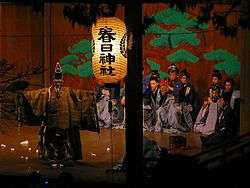
Japanese music is eclectic and diverse. Many instruments, such as the koto, were introduced in the 9th and 10th centuries. The popular folk music, with the guitar-like shamisen, dates from the 16th century.[281] Western classical music, introduced in the late 19th century, now forms an integral part of Japanese culture. The imperial court ensemble Gagaku has influenced the work of some modern Western composers.[282] Notable classical composers from Japan include Toru Takemitsu and Rentarō Taki. Popular music in post-war Japan has been heavily influenced by American and European trends, which has led to the evolution of J-pop.[283] Karaoke is the most widely practiced cultural activity in Japan.[284]
The four traditional theaters from Japan are noh, kyōgen, kabuki, and bunraku. Noh and kyōgen theater traditions are among the oldest continuous theater traditions in the world.
Customs and holidays

Ishin-denshin (以心伝心) is a Japanese idiom which denotes a form of interpersonal communication through unspoken mutual understanding.[285] Isagiyosa (潔さ) is a virtue of the capability of accepting death with composure. Cherry blossoms are a symbol of isagiyosa in the sense of embracing the transience of the world.[286] Hansei (反省) is a central idea in Japanese culture, meaning to acknowledge one's own mistake and to pledge improvement. Kotodama (言霊) refers to the Japanese belief that mystical powers dwell in words and names.[287] There are many annual festivals in Japan, which are called in Japanese matsuri (祭). There are no specific festival days for all of Japan; dates vary from area to area, and even within a specific area, but festival days do tend to cluster around traditional holidays such as Setsubun or Obon.
Officially, Japan has 16 national, government-recognized holidays. Public holidays in Japan are regulated by the Public Holiday Law (国民の祝日に関する法律, Kokumin no Shukujitsu ni Kansuru Hōritsu) of 1948.[288] Beginning in 2000, Japan implemented the Happy Monday System, which moved a number of national holidays to Monday in order to obtain a long weekend. The national holidays in Japan are New Year's Day on January 1, Coming of Age Day on Second Monday of January, National Foundation Day on February 11, The Emperor's Birthday on February 23, Vernal Equinox Day on March 20 or 21, Shōwa Day on April 29, Constitution Memorial Day on May 3, Greenery Day on May 4, Children's Day on May 5, Marine Day on Third Monday of July, Mountain Day on August 11, Respect for the Aged Day on Third Monday of September, Autumnal Equinox on September 23 or 24, Health and Sports Day on Second Monday of October, Culture Day on November 3, and Labor Thanksgiving Day on November 23.[289]
Cuisine
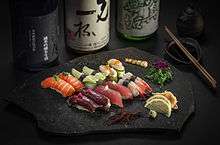
Japanese cuisine is known for its emphasis on seasonality of food, quality of ingredients and presentation. Japanese cuisine offers a vast array of regional specialties that use traditional recipes and local ingredients. Seafood and Japanese rice or noodles are traditional staple of Japanese cuisine, typically seasoned with a combination of dashi, soy sauce, mirin, vinegar, sugar, and salt. Dishes inspired by foreign food—in particular Chinese food—like ramen and gyōza, as well as foods like spaghetti, curry, and hamburgers have become adopted with variants for Japanese tastes and ingredients. Japanese curry, since its introduction to Japan from British India, is so widely consumed that it can be called a national dish.[290] Traditional Japanese sweets are known as wagashi.[291] Ingredients such as red bean paste and mochi are used. More modern-day tastes includes green tea ice cream.[292]
Popular Japanese beverages include sake, which is a brewed rice beverage that typically contains 14–17% alcohol and is made by multiple fermentation of rice.[293] Beer has been brewed in Japan since the late 17th century.[294] Green tea is produced in Japan and prepared in various forms such as matcha, used in the Japanese tea ceremony.[295]
Media
Television and newspapers take an important role in Japanese mass media, though radio and magazines also take a part.[296][297] Over the 1990s, television surpassed newspapers as Japan's main information and entertainment medium.[298] There are six nationwide television networks: NHK (public broadcasting), Nippon Television (NTV), Tokyo Broadcasting System (TBS), Fuji Network System (FNS), TV Asahi (EX) and TV Tokyo Network (TXN).[297] Television networks were mostly established based on capital investments by existing radio networks. Variety shows, serial dramas, and news constitute a large percentage of Japanese television shows. According to the 2015 NHK survey on television viewing in Japan, 79 percent of Japanese watch television daily.[299]
Japanese readers have a choice of approximately 120 daily newspapers, with an average subscription rate of 1.13 newspapers per household.[300] The main newspapers are the Yomiuri Shimbun, Asahi Shimbun, Mainichi Shimbun, Nikkei Shimbun and Sankei Shimbun. According to a survey conducted by the Japanese Newspaper Association in 1999, 85.4 percent of men and 75 percent of women read a newspaper every day.[298]
Japan has one of the oldest and largest film industries in the world; movies have been produced in Japan since 1897.[301] Ishirō Honda's Godzilla became an international icon of Japan and spawned an entire subgenre of kaiju films, as well as the longest-running film franchise in history. Japan has won the Academy Award for the Best Foreign Language Film four times, more than any other Asian country. Japanese animated films and television series, known as anime, were largely influenced by Japanese manga and have been extensively popular in the West. Japan is a world-renowned powerhouse of animation.[302]
Sports
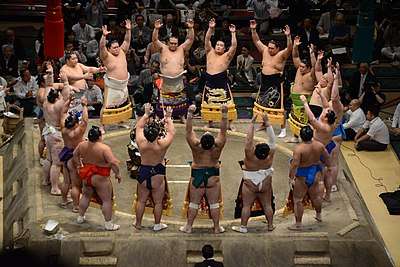
Traditionally, sumo is considered Japan's national sport.[303] Japanese martial arts such as judo, karate and kendo are also widely practiced and enjoyed by spectators in the country. After the Meiji Restoration, many Western sports were introduced.[304] Baseball is currently the most popular spectator sport in the country. Japan's top professional league, now known as Nippon Professional Baseball, was established in 1936[305] and is widely considered to be the highest level of professional baseball in the world outside of the North American Major Leagues. Since the establishment of the Japan Professional Football League in 1992, association football has also gained a wide following.[306] Japan was a venue of the Intercontinental Cup from 1981 to 2004 and co-hosted the 2002 FIFA World Cup with South Korea.[307] Japan has one of the most successful football teams in Asia, winning the Asian Cup four times,[308] and the FIFA Women's World Cup in 2011.[309] Golf is also popular in Japan.[310]
Japan has significant involvement in motorsport. Japanese automotive manufacturers have been successful in multiple different categories, with titles and victories in series such as Formula One, MotoGP, IndyCar, World Rally Championship, World Endurance Championship, World Touring Car Championship, British Touring Car Championship and the IMSA SportsCar Championship.[311][312][313] Three Japanese drivers have achieved podium finishes in Formula One, and drivers from Japan also have victories at the Indianapolis 500 and the 24 Hours of Le Mans, in addition to success in domestic championships.[314][315] Super GT is the most popular national series in Japan, while Super Formula is the top level domestic open-wheel series.[316] The country also hosts major races such as the Japanese Grand Prix, Japanese motorcycle Grand Prix, Suzuka 10 Hours, 6 Hours of Fuji, FIA WTCC Race of Japan and the Indy Japan 300.
Japan hosted the Summer Olympics in Tokyo in 1964 and the Winter Olympics in Sapporo in 1972 and Nagano in 1998.[317] Further, the country hosted the official 2006 Basketball World Championship.[318] Tokyo will host the 2020 Summer Olympics, making Tokyo the first Asian city to host the Olympics twice.[319] The country gained the hosting rights for the official Women's Volleyball World Championship on five occasions, more than any other nation.[320] Japan is the most successful Asian Rugby Union country, winning the Asian Five Nations a record six times and winning the newly formed IRB Pacific Nations Cup in 2011. Japan also hosted the 2019 IRB Rugby World Cup.[321]
Notes
- In English, the official name of the country is simply "Japan".[1] In Japanese, the name of the country as it appears on official documents, including the country's constitution, is 日本国 (

- According to the Dentsu survey of 2006: 1% Protestants, 0.8% members of the Catholic Church, and 0.5% members of the Orthodox Church.[242]
References
- "Official Names of Member States (UNTERM)" (PDF). UN Protocol and Liaison Service. United Nations. Retrieved May 21, 2020.
- "令和元年全国都道府県市区町村別面積調(10月1日時点)" (in Japanese). Geospatial Information Authority of Japan. December 26, 2019. Archived from the original on April 15, 2020.
- "Population Estimates Monthly Report (July 2020)". Statistics Bureau of Japan. July 20, 2020.
- "2015 Population Census: Basic Complete Tabulation on Population and Households" (PDF). Statistics Bureau of Japan. October 2016. Retrieved January 2, 2020.
- "World Economic Outlook Database, October 2019". International Monetary Fund. Retrieved October 30, 2019.
- "Income inequality". OECD. Archived from the original on September 18, 2019. Retrieved May 21, 2020.
- "Human Development Report 2019" (PDF). United Nations Development Programme. December 10, 2019.
- Schreiber, Mark (November 26, 2019). "You say 'Nihon,' I say 'Nippon,' or let's call the whole thing 'Japan'?". The Japan Times.
- Carr, Michael (March 1992). "Wa Wa Lexicography". International Journal of Lexicography. 5 (1): 1–31. doi:10.1093/ijl/5.1.1. ISSN 0950-3846.
- Piggott, Joan R. (1997). The emergence of Japanese kingship. Stanford University Press. pp. 143–144. ISBN 978-0-8047-2832-4.
- Hoffman, Michael (July 27, 2008). "Cipangu's landlocked isles". The Japan Times Online. Archived from the original on August 25, 2018.
- Lach, Donald (2010). Asia in the Making of Europe. I. University of Chicago Press. p. 157.
- Mancall, Peter C. (2006). "Of the Ilande of Giapan, 1565". Travel narratives from the age of discovery: an anthology. Oxford University Press. pp. 156–157.
- Batchelor, Robert K. (January 6, 2014). London: The Selden Map and the Making of a Global City, 1549–1689. University of Chicago Press. pp. 76, 79. ISBN 978-0-226-08079-6.
- Ono, Akira; Sato, Hiroyuki; Tsutsumi, Takashi; Kudo, Yuichiro (2002). "Radiocarbon Dates and Archaeology of the Late Pleistocene in the Japanese Islands". Radiocarbon. 44 (2): 477–494. doi:10.1017/S0033822200031854. ISSN 0033-8222.
- Habu, Junko (2004). Ancient Jomon of Japan. Cambridge University Press. p. 43. ISBN 978-0-521-77670-7.
- Kuzmin, Y.V. (2006). "Chronology of the Earliest Pottery in East Asia: Progress and Pitfalls". Antiquity. 80 (308): 362–371. doi:10.1017/s0003598x00093686.
- Oh, ChungHae Amana (2011). Cosmogonical Worldview of Jomon Pottery. Sankeisha. p. 37. ISBN 978-4-88361-924-5.
- "Road of rice plant". National Science Museum of Japan. Archived from the original on April 30, 2011. Retrieved January 15, 2011.
- "Kofun Period". Metropolitan Museum of Art. Retrieved January 15, 2011.
- "Yayoi Culture". Metropolitan Museum of Art. Retrieved January 15, 2011.
- Brown, Delmer M.; Hall, John Whitney; Jansen, Marius B.; Shively, Donald H.; Twitchett, Denis (1988). The Cambridge History of Japan: Volume 1. Cambridge University Press. p. 275. ISBN 978-0-521-22352-2.
- "From Jimmu Tennō to Perry Sea Power in Early Japanese History". The American Historical Review. October 1945. doi:10.1086/ahr/51.1.1. ISSN 1937-5239.
- Brown, Delmer M.; Hall, John Whitney; Jansen, Marius B.; Shively, Donald H.; Twitchett, Denis (1988). The Cambridge History of Japan. 1. Cambridge University Press. pp. 140–149. ISBN 978-0-521-22352-2.
- Beasley, William Gerald (1999). The Japanese Experience: A Short History of Japan. University of California Press. p. 42. ISBN 978-0-520-22560-2.
- Sansom, George (1961). A History of Japan: 1334–1615. Stanford University Press. pp. 57, 68. ISBN 978-0-8047-0525-7.
- Totman, Conrad (2002). A History of Japan. Blackwell. pp. 107–108. ISBN 978-1-4051-2359-4.
- Totman, Conrad (2002). A History of Japan. Blackwell. pp. 64–79. ISBN 978-1-4051-2359-4.
- Hays, J.N. (2005). Epidemics and pandemics: their impacts on human history. ABC-CLIO. p. 31. ISBN 978-1-85109-658-9.
- Totman, Conrad (2002). A History of Japan. Blackwell. pp. 79–87, 122–123. ISBN 978-1-4051-2359-4.
- Nussbaum, Louis-Frédéric. (2005). "Kamakura-jidai" in Japan Encyclopedia, p. 459.
- Totman, Conrad (2005). A History of Japan (2nd ed.). Blackwell. pp. 106–112. ISBN 978-1-4051-2359-4.
- Sansom, George (1961). A History of Japan: 1334–1615. Stanford University Press. pp. 42, 217. ISBN 978-0-8047-0525-7.
- Turnbull, Stephen (2010). Toyotomi Hideyoshi. Osprey Publishing. p. 61. ISBN 978-1-84603-960-7.
- Totman, Conrad (2005). A History of Japan (2nd ed.). Blackwell. pp. 142–143. ISBN 978-1-4051-2359-4.
- Toby, Ronald P. (1977). "Reopening the Question of Sakoku: Diplomacy in the Legitimation of the Tokugawa Bakufu". Journal of Japanese Studies. 3 (2): 323–363. doi:10.2307/132115. JSTOR 132115.
- Howe, Christopher (1996). The Origins of Japanese Trade Supremacy. Hurst & Company. pp. 58ff. ISBN 978-1-85065-538-1.
- Ohtsu, M.; Ohtsu, Makoto (1999). "Japanese National Values and Confucianism". Japanese Economy. 27 (2): 45–59. doi:10.2753/JES1097-203X270245.
- Totman, Conrad (2005). A History of Japan (2nd ed.). Blackwell. pp. 289–296. ISBN 978-1-4051-2359-4.
- McCargo, Duncan (2000). Contemporary Japan. Macmillan. pp. 18–19. ISBN 978-0-333-71000-5.
- A. Baran, Paul (1962). The Political Economy of Growth. Monthly Review Press. p. 160.
- Totman, Conrad (2005). A History of Japan (2nd ed.). Blackwell. pp. 312–314. ISBN 978-1-4051-2359-4.
- Matsusaka, Y. Tak (2009). "The Japanese Empire". In Tsutsui, William M. (ed.). Companion to Japanese History. Blackwell. pp. 224–241. ISBN 978-1-4051-1690-9.
- Hiroshi, Shimizu; Hitoshi, Hirakawa (1999). Japan and Singapore in the world economy: Japan's economic advance into Singapore, 1870–1965. Routledge. p. 17. ISBN 978-0-415-19236-1.
- Worth, Roland H., Jr. (1995). No Choice But War: the United States Embargo Against Japan and the Eruption of War in the Pacific. McFarland. pp. 56, 86. ISBN 978-0-7864-0141-3.
- Pape, Robert A. (1993). "Why Japan Surrendered". International Security. 18 (2): 154–201. doi:10.2307/2539100. JSTOR 2539100.
- Watt, Lori (2010). When Empire Comes Home: Repatriation and Reintegration in Postwar Japan. Harvard University Press. pp. 1–4. ISBN 978-0-674-05598-8.
- Coleman, Joseph (March 6, 2007). "'52 coup plot bid to rearm Japan: CIA". The Japan Times.
- "Japan scraps zero interest rates". BBC News. July 14, 2006.
- Fackler, Martin; Drew, Kevin (March 11, 2011). "Devastation as Tsunami Crashes Into Japan". The New York Times.
- "Japan's emperor thanks country, prays for peace before abdication". Nikkei Asian Review. Retrieved April 30, 2019.
- "Water Supply in Japan". Ministry of Health, Labour and Welfare. Archived from the original on January 26, 2018. Retrieved September 26, 2018.
- 離島とは(島の基礎知識) [what is a remote island?] (in Japanese). Ministry of Land, Infrastructure, Transport and Tourism. August 22, 2015. Archived from the original on November 13, 2007.
- McCargo, Duncan (2000). Contemporary Japan. Macmillan. pp. 8–11. ISBN 978-0-333-71000-5.
- 日本の領海等概念図. 海上保安庁海洋情報部. Archived from the original on August 12, 2018. Retrieved August 12, 2018.
- "CIA Factbook: Japan". Cia.gov. Retrieved August 27, 2019.
- "Japan". US Department of State. Retrieved January 16, 2011.
- "World Population Prospects". UN Department of Economic and Social Affairs. Archived from the original on March 21, 2007. Retrieved March 27, 2007.
- "Reclaimed Land in Japan". Japan Property Central. Archived from the original on February 26, 2018. Retrieved September 26, 2018.
- Israel, Brett (March 14, 2011). "Japan's Explosive Geology Explained". Live Science.
- "2013 World Risk Report" (PDF). Archived from the original (PDF) on August 16, 2014. Retrieved May 20, 2014.
- Barnes, Gina L. (2003). "Origins of the Japanese Islands" (PDF). University of Durham. Archived from the original (PDF) on April 28, 2011. Retrieved August 11, 2009.
- "Tectonics and Volcanoes of Japan". Oregon State University. Archived from the original on February 4, 2007. Retrieved March 27, 2007.
- James, C.D. (2002). "The 1923 Tokyo Earthquake and Fire" (PDF). University of California Berkeley. Archived from the original (PDF) on March 16, 2007. Retrieved January 16, 2011.
- Karan, Pradyumna Prasad; Gilbreath, Dick (2005). Japan in the 21st century. University Press of Kentucky. pp. 18–21, 41. ISBN 978-0-8131-2342-4.
- "Climate". JNTO. Archived from the original on February 18, 2011. Retrieved March 2, 2011.
- "Record High in Japan as Heat Wave Grips the Region". Archived from the original on July 23, 2018. Retrieved July 26, 2018.
- "Flora and Fauna: Diversity and regional uniqueness". Embassy of Japan in the USA. Archived from the original on February 13, 2007. Retrieved April 1, 2007.
- "The Wildlife in Japan" (PDF). Ministry of the Environment. Archived from the original (PDF) on March 23, 2011. Retrieved February 19, 2011.
- "National Parks of Japan". Ministry of the Environment. Retrieved May 11, 2011.
- "The Annotated Ramsar List: Japan". Ramsar. Archived from the original on September 17, 2011. Retrieved May 11, 2011.
- "Japan – Properties Inscribed on the World Heritage List". UNESCO. Retrieved July 5, 2011.
- 日本の大気汚染の歴史 (in Japanese). Environmental Restoration and Conservation Agency. Archived from the original on May 1, 2011. Retrieved March 2, 2014.
- Sekiyama, Takeshi. "Japan's international cooperation for energy efficiency and conservation in Asian region" (PDF). Energy Conservation Center. Archived from the original (PDF) on February 16, 2008. Retrieved January 16, 2011.
- "Environmental Performance Index: Japan". Yale University. Retrieved February 26, 2018.
- "Japan sees extra emission cuts to 2020 goal – minister". Reuters. June 24, 2009.
- "Environmental Performance Review of Japan" (PDF). OECD. Retrieved January 16, 2011.
- "The Constitution of Japan". Prime Minister of Japan and His Cabinet. November 3, 1946. Archived from the original on December 14, 2013.
- "Japan lowers voting age from 20 to 18 to better reflect young people's opinions in policies". The Straits Times. June 20, 2015.
- Fackler, Martin (December 27, 2013). "Ex-Premier Is Chosen To Govern Japan Again". The New York Times.
- Dean, Meryll (2002). Japanese legal system: text, cases & materials (2nd ed.). Cavendish. pp. 55–58. ISBN 978-1-85941-673-0.
- Kanamori, Shigenari (January 1, 1999). "German influences on Japanese Pre-War Constitution and Civil Code". European Journal of Law and Economics. 7 (1): 93–95. doi:10.1023/A:1008688209052.
- "The Anomalous Life of the Japanese Constitution". Nippon.com. August 15, 2017. Archived from the original on August 11, 2019.
- Dean, Meryll (2002). Japanese legal system: text, cases & materials (2nd ed.). Cavendish. p. 131. ISBN 978-1-85941-673-0.
- "The Japanese Judicial System". Office of the Prime Minister of Japan. Retrieved March 27, 2007.
- In Japanese, 43 of the prefectures are called "ken" (県), Kyoto and Osaka are "fu" (府), Hokkaido is a "dō" (道) and Tokyo is a "to" (都). Although different in name they are functionally the same.
- McCargo, Duncan (2000). Contemporary Japan. Macmillan. pp. 84–85. ISBN 978-0-333-71000-5.
- "UK backs Japan for UNSC bid". Central Chronicle. Archived from the original on February 21, 2007. Retrieved March 28, 2007.
- "Japan-Australia Joint Declaration on Security Cooperation". Ministry of Foreign Affairs. Retrieved August 25, 2010.
- "Joint Declaration on Security Cooperation between Japan and India". Ministry of Foreign Affairs. October 22, 2008.
- "Statistics from the Development Co-operation Report 2015". OECD. Retrieved November 15, 2015.
- "Global Diplomacy Index – Country Rank". Lowy Institute. Retrieved April 1, 2018.
- Michael Green. "Japan Is Back: Why Tokyo's New Assertiveness Is Good for Washington". Real Clear Politics. Retrieved March 28, 2007.
- "Japan's Foreign Relations and Role in the World Today". Asia for Educators. Retrieved November 13, 2016.
- "Japan and South Korea agree WW2 'comfort women' deal". BBC News. December 28, 2015.
- Ju, Hyujung (2014). "Transformations of the Korean Media Industry by the Korean Wave: The Perspective of Glocalization". Korean Popular Culture in Global Context – via ProQuest ebrary.
- "Abe and Moon hold first talks in Hamburg, agree to resume reciprocal visits". The Japan Times Online. July 7, 2017.
- "Japanese Territory, Northern Territories". MOFA. April 4, 2014.
- "Japanese Territory, Takeshima". MOFA. July 30, 2014.
- "Japanese Territory, Senkaku Islands". MOFA. April 13, 2016.
- "The 15 countries with the highest military expenditure in 2009". Stockholm International Peace Research Institute. Archived from the original on February 17, 2011. Retrieved January 16, 2011.
- "About RIMPAC". Government of Singapore. Archived from the original on August 6, 2013. Retrieved March 2, 2014.
- "Tokyo says it will bring troops home from Iraq". International Herald Tribune. June 20, 2006. Archived from the original on April 16, 2007.
- "Japan business lobby wants weapon export ban eased". Reuters. July 13, 2010.
- "Japan's Security Policy". Ministry of Foreign Affairs of Japan.
- "Abe offers Japan's help in maintaining regional security". Japan Herald. Archived from the original on May 31, 2014. Retrieved May 31, 2014.
- "Japan fires on 'intruding' boat". BBC. December 22, 2001.
- Herman, Steve (February 15, 2006). "Japan Mulls Constitutional Reform". Voice of America. Archived from the original on February 16, 2006.
- Supreme Court of Japan (2005). "Who will conduct the investigation?". Retrieved November 1, 2018.
- National Police Agency Police History Compilation Committee, ed. (1977). Japan post-war police history (in Japanese). Japan Police Support Association. p. 320.
- National Police Agency Police History Compilation Committee, ed. (1977). Japan post-war police history (in Japanese). Japan Police Support Association.
- "Chapter IV. Maintenance of Public Safety and Disaster Countermeasures" (PDF). Japanese National Police Agency. Archived from the original (PDF) on March 26, 2011. Retrieved March 25, 2011.
- "Brochure of Japan Coast Guard" (PDF). Japan Coast Guard. Archived (PDF) from the original on July 8, 2019. Retrieved July 8, 2019.
- "Diet tightens laws on knives, guns". Japan Times. November 29, 2008.
- Fisher, Max (July 23, 2012). "A Land Without Guns: How Japan Has Virtually Eliminated Shooting Deaths". The Atlantic.
- UNODC. "Data and Analysis>Crime surveys>The periodic United Nations Surveys of Crime Trends and Operations of Criminal Justice Systems>Fifth Survey (1990–1994)". Archived from the original on July 29, 2009. Retrieved August 26, 2008.
- UNODC. "Data and Analysis>Crime surveys>The periodic United Nations Surveys of Crime Trends and Operations of Criminal Justice Systems>Sixth Survey (1995–1997)>Sorted by variable". Retrieved August 26, 2008.
- UNODC. "Data and Analysis>Crime surveys>The periodic United Nations Surveys of Crime Trends and Operations of Criminal Justice Systems>Seventh Survey (1998–2000)>Sorted by variable". Retrieved August 26, 2008.
- UNODC. "Data and Analysis>Crime surveys>The periodic United Nations Surveys of Crime Trends and Operations of Criminal Justice Systems>Eighth Survey (2001–2002)>Sorted by variable". Retrieved August 26, 2008.
- UNODC. "Data and Analysis>Crime surveys>The periodic United Nations Surveys of Crime Trends and Operations of Criminal Justice Systems>Ninth Survey (2003–2004)>Values and Rates per 100,000 Total Population Listed by Country". Retrieved August 26, 2008.
- Inman, James (January 21, 2011). "China confirmed as World's Second Largest Economy". The Guardian.
- "World Factbook, Country comparison: Public debt". CIA. Retrieved August 20, 2017.
- "Manufacturing and Construction". Statistical Handbook of Japan. Statistics Bureau. Retrieved January 16, 2011.
- Fackler, Martin (April 21, 2010). "Japan Tries to Face Up to Growing Poverty Problem". The New York Times.
- "2008 Housing and Land Survey". Statistics Bureau. Retrieved January 20, 2011.
- "Economic survey of Japan 2008". OECD. Archived from the original on November 9, 2010. Retrieved August 25, 2010.
- "Japan's Economy: Free at last". The Economist. July 20, 2006.
- "Activist shareholders swarm in Japan". The Economist. June 28, 2007.
- "The 2018 World Cooperative Monitor: Exploring the Cooperative Economy" (PDF). International Co-operative Alliance. October 2018.
- "Country/Economy Profiles: Japan". World Economic Forum. Retrieved February 24, 2016.
- "Competitiveness Rankings". World Economic Forum. Retrieved February 24, 2016.
- "Japan Country Report". Global Finance. Retrieved November 16, 2013.
- "As Farmers Age, Japan Rethinks Relationship With Food, Fields". PBS. June 12, 2012. Archived from the original on November 21, 2013.
- "Trip Report – Japan Agricultural Situation". US Department of Agriculture. August 17, 2012. Archived from the original on December 15, 2013.
- Nagata, Akira; Chen, Bixia (May 22, 2012). "Urbanites Help Sustain Japan's Historic Rice Paddy Terraces". Our World.
- "With fewer, bigger plots and fewer part-time farmers, agriculture could compete". The Economist. April 13, 2013.
- "How will Japan's farms survive?". The Japan Times. June 28, 2013.
- "World review of fisheries and aquaculture". Food and Agriculture Organization. Retrieved January 18, 2014.
- "The state of world fisheries and aquaculture" (PDF). Food and Agriculture Organization. 2018. Retrieved May 25, 2020.
- "World fisheries production, by capture and aquaculture, by country (2010)" (PDF). Food and Agriculture Organization. Archived from the original (PDF) on May 25, 2017. Retrieved January 18, 2014.
- "Japan: Economy". World Factbook. Central Intelligence Agency. November 3, 2016.
- "UN tribunal halts Japanese tuna over-fishing". Asia Times. August 31, 1999.
- Black, Richard (June 22, 2005). "Japanese whaling 'science' rapped". BBC News.
- OICA (2016). "Production Statistics". Retrieved November 13, 2016.
- "Forbes Global 2000". Forbes. Retrieved November 14, 2016.
- "Manufacturing, value added (current US$) | Data". World Bank. Retrieved March 17, 2020.
- "2015 Global 2000: The World's Biggest Auto Companies". Forbes. May 6, 2015.
- "Why the sun has yet to set on Japanese shipbuilding". Seatrade Maritime News. Retrieved November 13, 2016.
- "Fortune Global 500". CNN Money. Retrieved November 16, 2013.
- "The World's Biggest Public Companies". Forbes. Retrieved November 16, 2013.
- "National Newspapers Total Circulation 2011". International Federation of Audit Bureaux of Circulations. Retrieved February 2, 2014.
- "The Keiretsu of Japan". San José State University.
- Otake, Tomoko (January 19, 2016). "Visitors to Japan surge to record 19.73 million, spend all-time high ¥3.48 trillion". The Japan Times Online.
- "2016 Foreign Visitors & Japanese Departures" (PDF). Japan National Tourism Organization. Retrieved January 29, 2017.
- Otake, Tomoko (January 29, 2017). "Number of foreign visitors to Japan tops 20 million mark for first time". The Japan Times Online.
- "Japan Total Visitor Numbers Over 24 Million in 2016!". Japan National Tourism Organization-UK Global Office. Retrieved January 29, 2017 – via Japan Times Online.
- "Number of visitors to Japan". Japan Macro Advisors. Retrieved January 29, 2017.
- "SMAM Market Keyword (No.139)" (PDF). SMAM-jp.com. Retrieved January 29, 2017.
- "UNWTO Tourism Highlights 2015 Edition" (Press release). UNWTO. June 25, 2015. doi:10.18111/9789284416899.
- Silver, Nate (August 18, 2014). "The Countries Where You're Surrounded By Tourists". FiveThirtyEight.
- "International tourism, number of arrivals – United States, Japan, Germany, United Kingdom, France, Italy, Canada | Data". World Bank. Retrieved March 19, 2020.
- "The Bloomberg Innovation Index". Bloomberg.
- David Shamah (February 4, 2015). "Bloomberg: Israel Is World's 5th Most Innovative Country, Ahead Of US, UK". No Camels.
- McDonald, Joe (December 4, 2006). "China to spend $136 billion on R&D". BusinessWeek.
- "Invest in Israel – Where Breakthroughs Happen" (PDF). Investment Promotion Center. Industry, Trade and Labor Ministry. December 4, 2011. p. 17.
- "Japanese Nobel Laureates". Kyoto University. 2009. Retrieved November 7, 2009.
- "Japanese Fields Medalists". Kyoto University. 2009. Archived from the original on March 10, 2010. Retrieved November 7, 2009.
- "Statistics – IFR International Federation of Robotics". Archived from the original on March 27, 2016. Retrieved October 5, 2016.
- Shteinbuk, Eduard (July 22, 2011). "R&D and Innovation as a Growth Engine" (PDF). National Research University – Higher School of Economics.
- Dutta, Soumitra; Lopez-Claros, Augusto; Mia, Irene. "Israel: Factors in the Emergence of an ICT Powerhouse" (PDF). World Economic Forum. Archived from the original (PDF) on April 16, 2012.
- Ettinger, Yoram. "Investing in Israel". New York Jewish Times. Archived from the original on May 9, 2013. Retrieved March 18, 2013.
- "The era of Japanese consumer electronics giants is dead". CNET. Retrieved November 13, 2016.
- "What happened to Japan's electronic giants?". BBC News. April 2, 2013. Retrieved November 13, 2016.
- Boxer, Steve (March 2, 2012). "Feature: Is Japan's development scene doomed?". ComputerAndVideoGames.com.
- "Why Japanese Games are Breaking Up With the West from". 1UP.com. Archived from the original on November 10, 2016. Retrieved October 1, 2012.
- Lah, Kyung (February 8, 2012). "Japan's older generation turns gamers". CNN.
- Herman, Leonard; Horwitz, Jer; Kent, Steve; Miller, Skyler (2002). "The History of Video Games". GameSpot. Archived from the original on September 29, 2007. Retrieved April 1, 2007.
- Tabuchi, Hiroko (September 20, 2010). "Japanese Playing a New Video Game: Catch-Up". The New York Times.
- "PAX '07: Japanese Gaming Culture 101". GameSpot. August 26, 2007.
- "GameSpy: Video Game Culture Clash". Uk.gamespy.com. Archived from the original on January 24, 2013. Retrieved October 1, 2012.
- Sambe, Yukiharu (2009). Japan's Arcade Games and Their Technology. Lecture Notes in Computer Science. Entertainment Computing – ICEC 2009. 5709. p. 338. doi:10.1007/978-3-642-04052-8_62. ISBN 978-3-642-04051-1.
- Negishi, Mayumi (December 11, 2013). "Japan Tops World In Mobile Apps Revenue". Wall Street Journal.
- Nutt, Christian. "Japan's game market hits record high as consoles decline and mobile grows". Gamasutra. Retrieved March 25, 2018.
- "Japan Aerospace Exploration Agency Homepage". Japan Aerospace Exploration Agency. August 3, 2006. Archived from the original on March 21, 2007.
- "Japan Plans Moon Base by 2030". MoonDaily. August 3, 2006.
- "Japan Successfully Launches Lunar Explorer "Kaguya"". Japan Corporate News Network. Archived from the original on April 30, 2011. Retrieved August 25, 2010.
- "Japan launches first lunar probe". BBC News. September 14, 2007.
- "Japanese probe crashes into Moon". BBC News. June 11, 2009.
- Pollack, Andrew (March 1, 1997). "Japan's Road to Deep Deficit is Paved with Public Works". The New York Times.
- "Transport". Statistical Handbook of Japan 2007. Statistics Bureau. Archived from the original on April 27, 2011. Retrieved March 2, 2014.
- Chapter 12 Transport – Microsoft Excel Sheet, Statistical Handbook of Japan
- "Road Bureau – MLIT Ministry of Land, Infrastructure, Transport and Tourism".
- "Transport in Japan". International Transport Statistics Database. International Road Assessment Program. Retrieved February 17, 2009. (subscription required)
- "About the Shinkansen – Safety". Central Japan Railway Company. Retrieved October 17, 2011.
- "Corporate Culture as Strong Diving Force for Punctuality- Another "Just in Time"". Hitachi. Archived from the original on May 13, 2008. Retrieved April 19, 2009.
- "Maglev launch to be delayed to 2027". Asahi Shimbun. April 30, 2010. Archived from the original on October 26, 2010.
- "Year to Date Passenger Traffic". Airports Council International. November 11, 2010. Archived from the original on January 11, 2011.
- Nakagawa, Dai; Matsunaka, Ryoji (2006). Transport Policy and Funding. Elsevier. p. 63. ISBN 978-0-08-044852-7.
- "Port Profile". Port of Nagoya. Archived from the original on November 30, 2010. Retrieved January 7, 2011.
- "Energy" (PDF). Statistical Handbook of Japan 2019. Statistics Bureau. Retrieved July 1, 2020.
- Tsukimori, Osamu (May 5, 2012). "Japan nuclear power-free as last reactor shuts". Reuters.
- "Nuclear power back in Japan for first time since Fukushima". BBC News. August 11, 2015.
- "Can nuclear power save Japan from peak oil?". Our World 2.0. February 2, 2011.
- "Japan". U.S. Department of State. Retrieved March 15, 2011.
- Waterworks Vision Summary, June 2004, retrieved on January 6, 2011
- Ministry of Health, Labor and Welfare:Coverage, retrieved on January 6, 2011
- "Population Estimates Monthly Report June 2019". Statistics Bureau Japan. June 20, 2019. Archived from the original on June 6, 2019.
- "Japan population drops by record number to 124.8 mil.: gov't". The Mainichi. July 10, 2019. Archived from the original on July 11, 2019.
- 平成22年国勢調査最終報告書 人口の地域分布 (PDF). Ministry of Internal Affairs and Communications Statistics Bureau. Retrieved October 14, 2015.
- 東京都の人口(推計) [Population of Tokyo (estimate)]. Tokyo Metropolitan Government Bureau of Statistics Department. Archived from the original on October 2, 2018. Retrieved October 22, 2018.
- "Table 2.10 Population of Three Major Metropolitan Areas". Statistics Bureau of Japan. Retrieved November 26, 2013.
- "The World's Cities in 2016" (PDF). United Nations. March 12, 2017.
- "'Multicultural Japan' remains a pipe dream". Japan Times. March 27, 2007. Archived from the original on April 14, 2011.
- Atsushi Kotani (2010). 日本文化論のインチキ [The Fascination of the Japanese Cultural Theory]. Gentensei Shinko Shinbun. ISBN 978-4-344-98166-9.
- Fogarty, Philippa (June 6, 2008). "Recognition at last for Japan's Ainu". BBC.
- "The Invisible Race". Time. January 8, 1973.
- "Japan-born Koreans live in limbo". The New York Times. April 2, 2005.
- Onishi, Norimitsu (November 1, 2008). "An Enclave of Brazilians Is Testing Insular Japan". The New York Times.
- "'Home' is where the heartbreak is for Japanese-Peruvians". Asia Times. October 16, 1999.
- "Registered Foreigners in Japan by Nationality" (PDF). Statistics Bureau. Archived from the original (PDF) on August 24, 2005. Retrieved January 16, 2011.
- "Table A.17" (PDF). United Nations World Population Prospects, 2006 revision. UN. Retrieved January 15, 2011.
- "WHO: Life expectancy in Israel among highest in the world". Haaretz. May 2009. Retrieved January 15, 2011.
- "Statistical Handbook of Japan 2013: Chapter 2 – Population". Statistics Bureau. Retrieved February 14, 2014.
- "For the first time, 1 person in 5 in Japan is 70 or older". The Japan Times Online. September 17, 2018.
- Gonzalo Garland et al. "Dynamics of Demographic Development and its impact on Personal Saving : case of Japan", with Albert Ando, Andrea Moro, Juan Pablo Cordoba, in Ricerche Economiche, Vol 49, August 1995
- Ogawa, Naohiro. "Demographic Trends and their implications for Japan's future". Transcript of speech delivered on March 7, 1997. Ministry of Foreign Affairs. Retrieved May 14, 2006.
- "frm_Message". Retrieved October 5, 2016.
- Sakanaka, Hidenori (October 5, 2005). "Japan Immigration Policy Institute: Director's message". Japan Immigration Policy Institute. Archived from the original on September 29, 2007.
- French, Howard (July 24, 2003). "Insular Japan Needs, but Resists, Immigration". The New York Times.
- 帰化許可申請者数等の推移 (in Japanese). Ministry of Justice. Retrieved March 17, 2011.
- "New immigration rules to stir up Japan's regional rentals scene — if they work". REthink Tokyo. Archived from the original on July 2, 2019. Retrieved July 2, 2019.
- "A View of Religion in Japan". Archived from the original on January 23, 2016. Retrieved January 29, 2017.
- Reischauer, Edwin O.; Jansen, Marius B. (1988). The Japanese today: change and continuity (2nd ed.). Belknap Press of Harvard University Press. p. 215. ISBN 978-0-674-47184-9.
- "Religion – Japanese Culture". Inside Japan Tours. Retrieved December 23, 2019.
- "How religious are Japanese people?". Retrieved December 23, 2019.
- Kisala, Robert (2005). Wargo, Robert (ed.). The Logic Of Nothingness: A Study of Nishida Kitarō. University of Hawaii Press. pp. 3–4. ISBN 978-0-8248-2284-2.
- Totman, Conrad (2005). A History of Japan (2nd ed.). Blackwell. p. 72. ISBN 978-1-4051-2359-4.
- Higashibaba, 2002. p. 1
- Mariko Kato (February 24, 2009). "Christianity's long history in the margins". The Japan Times Online.
The Christian community itself counts only those who have been baptized and are currently regular churchgoers – some 1 million people, or less than 1 percent of the population, according to Nobuhisa Yamakita, moderator of the United Church of Christ in Japan
- "Christians use English to reach Japanese youth". Mission Network News. September 3, 2007. Archived from the original on June 11, 2010.
The population of Japan is less than one-percent Christian
- Heide Fehrenbach, Uta G. Poiger (2000). Transactions, transgressions, transformations: American culture in Western Europe and Japan. Berghahn Books. p. 62. ISBN 978-1-57181-108-0.
followers of the Christian faith constitute only about a half percent of the Japanese population
- 世界60カ国価値観データブック [Sixty Countries' Values Databook]. Dentsu Communication Institute, Japan Research Center. 2000.
- Routledge Handbook of Japanese Culture and Society (2011) edited by Victoria Bestor, Theodore C. Bestor, and Akiko Yamagata, p. 65 ISBN 978-0-415-43649-6
- Kato, Mariko (February 24, 2009). "Christianity's long history in the margins". Japan Times.
- "Emile A. Nakhleh, Keiko Sakurai and Michael Penn; "Islam in Japan: A Cause for Concern?", Asia Policy 5, January 2008" (PDF). Archived from the original (PDF) on October 10, 2017. Retrieved November 4, 2016.
- Kawakami, Yasunori. "Local Mosques and the Lives of Muslims in Japan – The Asia-Pacific Journal: Japan Focus". www.japanfocus.org.
- "Table: Muslim Population by Country". Pew Research Center. January 27, 2011.
- バハイ共同体 【Japan Baha'i Network】.
- Clarke, Peter, ed. (1993). The World's religions : understanding the living faiths. Reader's Digest. p. 208. ISBN 978-0-89577-501-6.
- Miyagawa, Shigeru. "The Japanese Language". Massachusetts Institute of Technology. Retrieved January 16, 2011.
- Ellington, Lucien (September 1, 2005). "Japan Digest: Japanese Education". Indiana University. Archived from the original on April 27, 2006.
- Heinrich, Patrick (January 2004). "Language Planning and Language Ideology in the Ryūkyū Islands". Language Policy. 3 (2): 153–179. doi:10.1023/B:LPOL.0000036192.53709.fc.
- "15 families keep ancient language alive in Japan". UN. Archived from the original on January 6, 2008. Retrieved March 27, 2007.
- Ellington, Lucien (December 1, 2003). "Beyond the Rhetoric: Essential Questions About Japanese Education". Foreign Policy Research Institute. Archived from the original on April 5, 2007.
- "QS World University Rankings 2020". QS TopUniversities. 2019. Retrieved September 7, 2019.
- Jiji Press Staff (June 10, 2016). "Compulsory nine-year school system kicks off in Japan". The Japan Times.
- "Japan – Student performance (PISA 2015)". OECD.
- "Education at a Glance 2014" (PDF). OECD. Retrieved August 16, 2019.
- "PISA – Results in Focus" (PDF). OECD. p. 5.
- "Japan" (PDF). OECD.
- "Japan". OECD. Retrieved August 16, 2019.
- Rodwin, Victor. "Health Care in Japan". New York University. Retrieved March 10, 2007.
- Strom, Stephanie (July 15, 1999). "In Japan, Mired in Recession, Suicides Soar". The New York Times.
- Lewis, Leo (June 19, 2008). "Japan gripped by suicide epidemic". The Times.
- Ozawa-de Silva, Chikako (December 2008). "Too Lonely to Die Alone: Internet Suicide Pacts and Existential Suffering in Japan". Cult Med Psychiatry. 32 (4): 516–551. doi:10.1007/s11013-008-9108-0. PMID 18800195.
- Britnell, Mark (2015). In Search of the Perfect Health System. Palgrave. p. 18. ISBN 978-1-137-49661-4.
- Haffner, John; Klett, Tomas; Lehmann, Jean-Pierre (2009). Japan's Open Future: An Agenda for Global Citizenship. Anthem Press. p. 17. ISBN 978-1-84331-311-3.
- "Administration of Cultural Affairs in Japan". Agency for Cultural Affairs. Retrieved May 11, 2011.
- Arrowsmith, Rupert Richard (2010). Modernism and the Museum: Asian, African, and Pacific Art and the London Avant-Garde. Oxford University Press. ISBN 978-0-19-959369-9.
- Kinko Ito (February 2005). "A History of Manga in the Context of Japanese Culture and Society". Journal of Popular Culture. 38 (3): 456–475. doi:10.1111/j.0022-3840.2005.00123.x.
- Tange, Kenzo; Kawazoe, Noboru (1965). Ise: Prototype of Japanese Architecture. Massachusetts Institute of Technology Press.
- Kazuo, Nishi; Kazuo, Hozumi (1995). What is Japanese Architecture?: A Survey of Traditional Japanese Architecture with a List of Sites and a Map. Kodansha. ISBN 978-4-7700-1992-9.
- Keene, Donald (2000). Seeds in the Heart: Japanese Literature from Earliest Times to the Late Sixteenth Century. Columbia University Press. ISBN 978-0-231-11441-7.
- "Asian Studies Conference, Japan (2000)". Meiji Gakuin University. Retrieved April 1, 2007.
- "Windows on Asia – Literature : Antiquity to Middle Ages: Recent Past". Michigan State University. Archived from the original on December 3, 2005. Retrieved December 28, 2007.
- Totman, Conrad (2005). A History of Japan (2nd ed.). Blackwell. pp. 126–127. ISBN 978-1-4051-2359-4.
- Royall, Tyler, ed. (2003). The Tale of Genji. Penguin Classics. pp. i–ii, xii. ISBN 978-0-14-243714-8.
- Keene, Donald (1999). World Within Walls: Japanese Literature of the Pre-Modern Era, 1600–1867. Columbia University Press. ISBN 978-0-231-11467-7.
- "Japanese Confucian Philosophy". Stanford Encyclopedia of Philosophy. May 20, 2008.
- Parkes, Graham (January 1, 2011). Zalta, Edward N. (ed.). Japanese aesthetics. Stanford Encyclopedia of Philosophy.
- Malm, William P. (2000). Traditional Japanese music and musical instruments (New ed.). Kodansha International. pp. 31–45. ISBN 978-4-7700-2395-7.
- See for example, Olivier Messiaen, Sept haïkaï (1962), (Olivier Messiaen: a research and information guide, Routledge, 2008, By Vincent Perez Benitez, p. 67) and (Messiaen the Theologian, Ashgate Publishing, Ltd., 2010, pp. 243–265, By Andrew Shenton)
- Campion, Chris (August 22, 2005). "J-Pop History". The Observer.
- Martinez, D.P., ed. (1998). The worlds of Japanese popular culture: gender, shifting boundaries and global cultures (Repr. ed.). Cambridge University Press. p. 76. ISBN 978-0-521-63729-9.
- Maynard, Michael L; Maynard, Senko K; Taki (1993). 101 Japanese Idioms: Understanding Japanese Language and Culture Through Popular Phrases. McGraw Hill Professional. p. 113. ISBN 978-0-8442-8496-5.
- Richard J. Berenson, Neil deMause, The complete illustrated guidebook to Prospect Park and the Brooklyn Botanic Garden (2001), p. 121.
- Cohen, Raymond (1977). Negotiating Across Cultures: Communication Obstacles in International Diplomacy. United States Inst of Peace Pr (September 1, 1991). ISBN 978-1-878379-08-5.
- Nakamura, Akemi (April 8, 2008). "National holidays trace roots to China, ancients, harvests". Japan Times. Archived from the original on July 13, 2009.
- "Public Holidays in Japan in 2016". Office Holidays.
- Lucy M. Long (2015). Ethnic Food Today: A Cultural Encyclopedia. Rowman & Littlefield Publishers. pp. 329–. ISBN 978-1-4422-2731-6.
- Darra Goldstein (2015). The Oxford Companion to Sugar and Sweets. Oxford University Press. pp. 777–. ISBN 978-0-19-931339-6.
- Hiroko Fujita; Fran Stallings (2008). Folktales from the Japanese Countryside. Libraries Unlimited. pp. 148–. ISBN 978-1-59158-488-9.
- Carl A. Batt (2014). Encyclopedia of Food Microbiology. Academic Press. pp. 846–. ISBN 978-0-12-384733-1.
- Christopher Boulton; David Quain (2013). Brewing Yeast and Fermentation. John Wiley & Sons. pp. 20–. ISBN 978-1-118-68534-1.
- Hosking, Richard (1995). A Dictionary of Japanese Food - Ingredients and Culture. Tuttle. p. 30. ISBN 0-8048-2042-2.
- "The Japanese and Television, 2000". Archived from the original on December 5, 2004. Retrieved November 3, 2016.
- Australia, Barbara Gatzen, Australian National University (April 17, 2001). "Media and Communication in Japan: Current Issues and Future Research".
- 2.新聞と読者 Newspapers and Readers. Archived from the original on April 18, 2002. Retrieved November 3, 2016.
- Television Viewing and Media Use Today: From "The Japanese and Television 2015" Survey NHK Broadcasting Culture Research Institute, Public Opinion Research Division. April 2016.
- 1.発行部数 Circulation. Archived from the original on April 18, 2002. Retrieved November 3, 2016.
- "Top 50 countries ranked by number of feature films produced, 2005–2010". Screen Australia. Archived from the original on October 27, 2012. Retrieved July 14, 2012.
- If you want to know Japan, See Animation Dong-ah-news, November 5, 2005 language = Korean
- "Sumo: East and West". PBS. Retrieved March 10, 2007.
- "Culture and Daily Life". Embassy of Japan in the UK. Archived from the original on March 17, 2007. Retrieved March 27, 2007.
- Nagata, Yoichi; Holway, John B. (1995). "Japanese Baseball". In Palmer, Pete (ed.). Total Baseball (4th ed.). Viking Press. p. 547.
- "Soccer as a Popular Sport: Putting Down Roots in Japan" (PDF). The Japan Forum. Retrieved April 1, 2007.
- "Previous FIFA World Cups". FIFA. Retrieved January 7, 2011.
- "Team Japan". Asian Football Confederation. Retrieved March 2, 2014.
- "Japan edge USA for maiden title". FIFA. July 17, 2011.
- Varcoe, Fred. "Japanese Golf Gets Friendly". Metropolis. Archived from the original on September 26, 2007. Retrieved April 1, 2007.
- "Honda". STATS F1. Retrieved February 21, 2020.
- "WRC – World Rally Championship". World Rally Championship. Retrieved February 21, 2020.
- Sports, Dorna. "Japanese industry in MotoGP™". www.motogp.com. Retrieved February 21, 2020.
- Nagatsuka, Kaz (June 14, 2017). "Sato revels in glow of historic Indy 500 triumph". The Japan Times Online.
- "Japan at the 24 Hours of Le Mans – Infographic". lemans.org. Retrieved February 21, 2020.
- Clarke, Len. "Japanese Omnibus: Sports". Metropolis. Archived from the original on September 26, 2007. Retrieved April 1, 2007.
- "Olympic History in Japan". Japanese Olympic Committee. Retrieved January 7, 2011.
- "2006 FIBA World Championship". FIBA. Retrieved May 10, 2017.
- "IOC selects Tokyo as host of 2020 Summer Olympic Games". International Olympic Committee. July 21, 2016.
- "The Game – World Championships – FIVB Women's World Championships Finals". FIVB. Retrieved June 13, 2017.
- "rugbyworldcup.com". Archived from the original on December 17, 2013. Retrieved November 1, 2013.
External links
Government
- JapanGov – The Government of Japan (in English)
- Prime Minister of Japan and His Cabinet Official website (in English)
- The Imperial Household Agency, official site of the Imperial House of Japan
- National Diet Library
General information
- Japan from UCB Libraries GovPubs
- Japan Encyclopædia Britannica entry
- Japan profile from BBC News
- Japan from the OECD




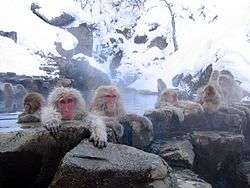
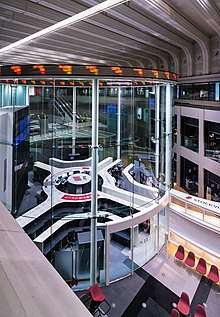
.jpg)


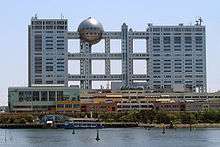
.svg.png)
